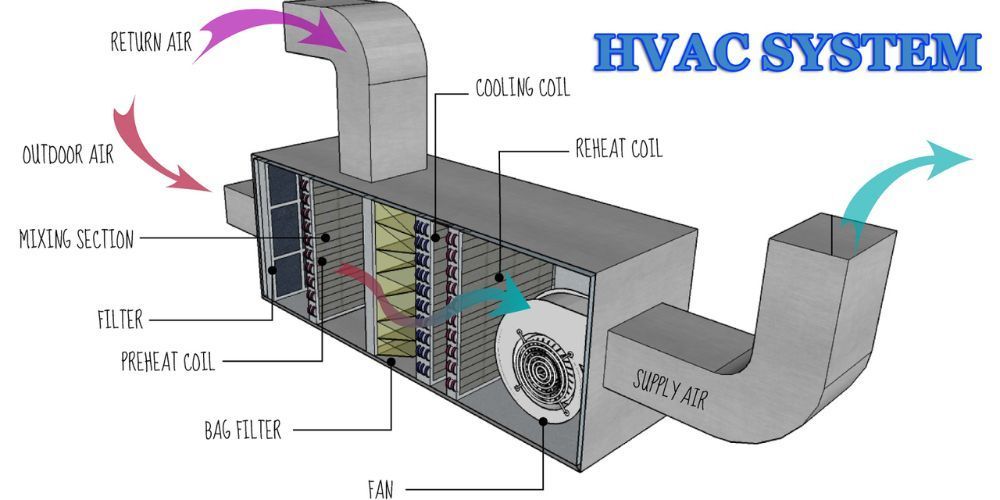
HVAC systems, which stand for Heating, Ventilation, and Air Conditioning, are vital for maintaining comfortable indoor environments. But what makes these systems tick? The answer lies in their intricate network of parts. Let's delve into the essential components that keep your home or building at the perfect temperature.
Essential Components of an HVAC System
Every HVAC system, regardless of its specific type, relies on a core set of components. Understanding these parts is crucial for proper maintenance and troubleshooting.
1. The Thermostat
The thermostat is the brain of your HVAC system. It's the control center that allows you to set your desired temperature. Modern thermostats can be programmable, smart, and even Wi-Fi enabled, offering greater convenience and energy efficiency. A faulty thermostat can lead to inconsistent temperatures, so it's important to ensure it's functioning correctly. When you are looking for a thermostat make sure it matches the type of system you have.
2. The Air Handler
The air handler, often part of the indoor unit, is responsible for circulating air throughout your home. It contains a blower fan, which pushes air through the ductwork, and an evaporator coil, which cools or heats the air. A well-maintained air handler ensures consistent airflow and efficient temperature regulation. The blower fan contained within the air handler is a crucial part of the HVAC system.
3. The Compressor
Located in the outdoor unit, the compressor is the heart of the cooling process. It pressurizes the refrigerant, which then flows through the system to absorb and release heat. A malfunctioning compressor can lead to inadequate cooling or even system failure. It is very expensive to replace a compressor.
4. The Condenser Coil

Also located in the outdoor unit, the condenser coil releases the heat absorbed by the refrigerant. Air is blown across the coil to dissipate the heat. Clean condenser coils are essential for efficient cooling. Dirty coils can reduce system performance and increase energy consumption. The condenser coil must be kept clean in order for your system to run efficiently.
5. The Evaporator Coil
The evaporator coil, located in the indoor unit, absorbs heat from the indoor air. As warm air passes over the coil, the refrigerant absorbs the heat, cooling the air. A clean evaporator coil ensures optimal cooling performance. A dirty evaporator coil can freeze over, and stop your system from working.
6. The Expansion Valve
The expansion valve regulates the flow of refrigerant into the evaporator coil. It controls the pressure and temperature of the refrigerant, ensuring efficient heat absorption. A properly functioning expansion valve is crucial for maintaining consistent cooling performance. The expansion valve is a precision component.
7. Ductwork
Ductwork is the network of channels that distribute conditioned air throughout your home. Properly sized and sealed ductwork is essential for efficient airflow. Leaky or poorly designed ductwork can lead to energy waste and inconsistent temperatures. Ductwork should be inspected regularly.
8. Air Filters

Air filters are essential for maintaining indoor air quality. They trap dust, pollen, and other airborne particles, preventing them from circulating through your home. Regular filter replacement is crucial for optimal performance and air quality. A clean air filter can improve the efficiency of your HVAC system.
9. Refrigerant Lines
Refrigerant lines carry the refrigerant between the indoor and outdoor units. Leaks in these lines can lead to refrigerant loss, reducing system performance and potentially damaging the environment. Regular inspections and maintenance are necessary to prevent leaks. The refrigerant lines are under high pressure.
10. Blower Motor
The blower motor powers the blower fan, which circulates air through the ductwork. A properly functioning blower motor ensures consistent airflow and temperature regulation. A failing blower motor can cause inconsistent air flow.
Maintenance Tips for HVAC Parts
Regular maintenance is essential for prolonging the lifespan of your HVAC system and ensuring optimal performance. Here are some key maintenance tips:
- Regularly replace air filters.
- Clean condenser and evaporator coils.
- Inspect and seal ductwork.
- Schedule annual professional maintenance.
- Ensure proper refrigerant levels.
- Check and test the thermostat.
- Lubricate moving parts.
- Check for leaks in refrigerant lines.

Troubleshooting Common HVAC Part Issues
Even with regular maintenance, HVAC parts can experience issues. Here are some common problems and their potential solutions:
- Thermostat Issues: Check batteries, wiring, and calibration.
- Compressor Failure: Contact a professional for repair or replacement.
- Evaporator Coil Freeze-up: Check airflow and refrigerant levels.
- Ductwork Leaks: Seal leaks with mastic or tape.
- Blower Motor Problems: Check for proper voltage and lubrication.
By understanding the key components of your HVAC system and performing regular maintenance, you can ensure optimal performance and longevity. Remember, when in doubt, consult a qualified HVAC professional. They have the expertise to diagnose and resolve complex issues, ensuring your home remains comfortable year-round.
No comments:
Post a Comment
Note: Only a member of this blog may post a comment.